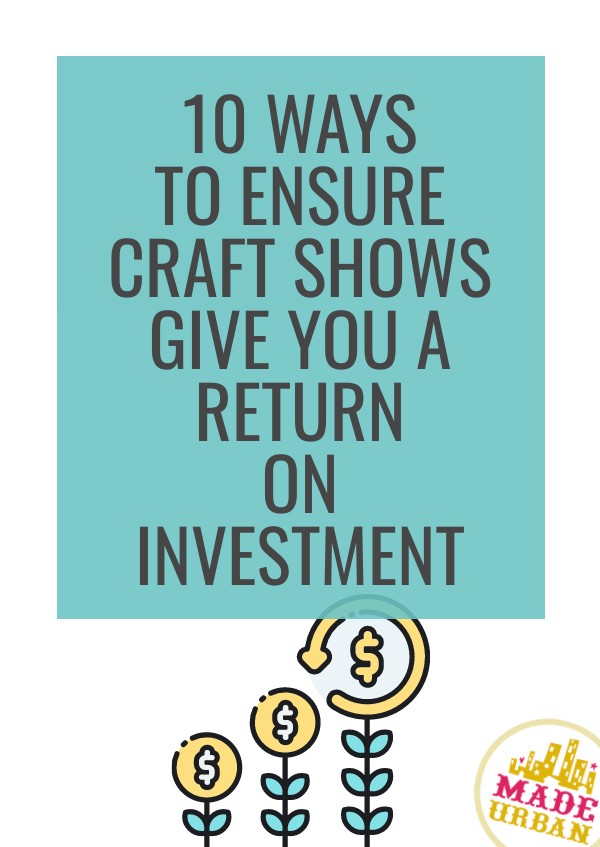10 Ways to Ensure Craft Shows Give you a Return on Investment
Craft shows typically require you to spend a lot of time and money to prepare for, sell at, and pack up from.
So you want to ensure the revenue that event produces, covers all your costs and leaves you with profits.
Return on investment tells you whether an investment (anything you spend time and/or money on to make money) was worth your time and money.
To calculate the ROI of a craft show:
Divide your profits from the craft show (revenue minus costs) by the investment cost (how much you spent on the craft show), then multiply that number by 100 to get a percentage.
For example, if I sold $1000 worth of products at a craft show and spent $750 on materials, wages, and event-related costs:
Profits = $250
Investment = $750
250 divided by 750 = 0.33
0.33 x 100 = 33%
The goal is to have a positive ROI.
If you’ve spent more than you earned, you’ll have a negative ROI.
Here are several tips to help ensure you make more than you spend.
1) Choose the right events
When I first started selling at craft shows, there weren’t many to choose from in my city. So I said yes to almost every event.
There was one in particular that taught me the importance of choosing the right events. It was at a prestigious private club that offers fitness facilities, dining, networking events, etc.
Memberships were tens of thousands of dollars, so I thought the craft show being held there would attract shoppers ready to spend money.
That wasn’t the case.
The people at the club were there to work out, dine, or socialize, not shop for crafts.
It can also be hard to earn your money back when a craft show’s fees are high and you’re selling low-price/low-profit items.
If my average price point is $5 and a booth costs $1000, I would need to sell 200 units just to cover my booth fees.
Be sure an event is:
- well marketed
- attracting a target market that fits your products
- gives you the potential to cover your costs
2) Decline trades
At that same event at the private club, a fellow vendor wanted to do a trade. She was selling candles and wanted one of my handbags.
For the trade to be fair, she needed to give me several candles in exchange for the bag she wanted. I honestly didn’t need candles, but felt put on the spot and said yes to the trade.
Instead of selling that bag (at the event or after) and getting revenue to cover my costs, I got a bunch of candles I had no use for.
Trades can be a great way to score amazing products.
But if your goal is to get a high return on investment, it’s okay to politely decline a trade offer.
Have a response ready to politely decline. You might let them know that you love their work but you have a sales goal you’re trying to hit.
>> Here are 6 Ways to Politely Decline Trades at Craft Shows
3) Know your numbers
When I first started selling at craft shows, my goal was to “sell as much stock as I could”. But if you want a return on investment, you first must know what the total investment is and how much you need to sell to get a return.
Be sure you’re considering all the costs associated with a craft show (10 Costs of Selling at Craft Fairs).
Then calculate how many sales you must make, or how much revenue you need, to cover all those cost and have money left over.
You should also know how much you want/need to profit to make all that work worth your time.
When you have clear goals, it’s more likely you’ll reach the numbers you need.
4) Increase your units per transaction
Consider the effort (and money) required to get a consumer’s attention, educate them on your business/brand/products, help them find the right product, complete a transaction, wrap their purchase, etc.
At the end of all that effort, would you prefer to have $10 in your pocket or $30?
When you can sell more to each customer, you reduce your costs and increase your profits.
Plan a product line that will help you sell more to each customer.
For example, if I’m selling bags, pajamas, and aprons, one customer is likely to buy one item. Someone shopping for an apron is not in the mindset to shop for a new purse.
But if instead, I sell aprons, oven mitts, pot holders, tea towels, reusable bowl covers, etc. someone buying an apron will also be interested in my other items and will be more likely to add the matching pot holders or tea towels to their order.
Plan your product line to encourage multi-item sales. Think about what one customer is likely to use/wear/display/consume with your key items.
>> 5 Strategies to Increase Units Per Transaction
>> How To Sell More to Each Customer (w/ a Ladder System)
5) Market the event
The event organizer should be taking care of the majority of marketing for the event (that’s part of what your booth fees cover).
However, if you have a following on social media or local newsletter subscribers, be sure to market the event to them and encourage them to visit your booth. You may even run a promotion your subscribers can take advantage of (e.g. “mention this newsletter and get 10% X item at the event”).
These are people who are already familiar with your business/brand/products and will require less effort to sell to.
>> How to Promote a Craft Show (as a vendor)
6) Market AT the event
Craft shows aren’t just for selling; they’re for marketing your business too.
For the majority of shoppers, this will be their first encounter with your business. And consumers don’t typically buy on a first encounter.
So use craft shows to introduce shoppers to your business and make a connection so you can stay in touch with them and have the opportunity to sell to them in the future.
- Hand out your business cards
- Share flyers listing the upcoming events where shoppers can find you
- Encourage shoppers to sign up for your newsletter
- Make a connection (shoppers are more likely to remember your business if they interact with you and your products. So don’t just smile and say hello. Have a conversation with each shopper and try to connect with them)
7) Set a budget
Some craft show costs will be fixed (e.g. you can’t change how much booth fees are). However, there will be some costs you can manage, such as how much you spend on:
- display elements
- marketing materials
- shopping bags
- product materials
- etc.
Your time is a cost (in the form of wages), so it’s important to be mindful of it.
I used to work as much as I could leading up to a craft show.
But once I set a “time budget,” I was more mindful of what I needed to work on and what was just busy work. I was also more productive. I figured out how to streamline my production when I knew I had X number of hours to make X number of products.
Setting a budget will help you be more mindful of how much you spend.
>> 10 Ways To Save Money When Selling at Craft Shows
8) Refine your product line
The more types of products and product options you add to your lineup, the more time and money you must spend:
- Sourcing materials
- Switching tools/stations
- Pricing
- Finding the right fixtures and ways to display a new product
- Creating signage
- Etc.
When you streamline your product line, you reduce your costs and time/wages, improving your profit margins.
>> How to Develop a Product Line Using the 3 – 5 Strategy
9) Sell
In the beginning, I didn’t think sales techniques would actually help me sell more. I told myself craft show shoppers are different and don’t like to be “sold to”.
However, when you’re running a business, the goal is to sell your products, and you can’t be passive.
I started applying sales techniques at shows and noticed a significant difference.
Unfortunately, it’s not enough to stand there and smile while people shop your products.
>> What to Say at Craft Shows to Get a Shopper’s Attention
>> Sell More at a Craft Show with a Simple Question
10) Save on travel and food costs
Find ways to save on some of the costs associated with selling at craft shows, such as travel costs, parking fees, and food.
You may:
- carpool with a fellow vendor so you can share gas and parking fees.
- find cheaper parking (which may require you to allot for extra time to walk a little further to the venue)
- pack a lunch, snacks, and drinks
I hope these tips help make your next craft show more profitable!


Hey, I’m Erin 🙂 I write about small business and craft show techniques I’ve learned from being a small business owner for almost 2 decades, selling at dozens of craft shows, and earning a diploma in Visual Communication Design. I hope you find my advice helpful!
